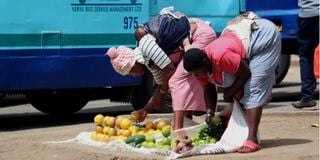Covid-19 to push 47 million women to poverty

Women selling fruits and vegetables at the Bus Station in Nairobi. A poverty forecast by UN Women and UNDP predicts a sharp increase in female poverty worldwide, placing such women in a dire situation.
Globally, girls and women have been the most affected by the disruption caused the Covid-19 pandemic.
From increased sexual and gender-based violence to loss of employment and businesses, to lack of reproductive health supplies and services, women have borne the brunt of the pandemic more than their male counterparts.
Last week, the latest poverty forecast by UN Women and UNDP predicted a sharp increase in female poverty worldwide.
In a press release, UN Women indicated that the poverty forecast project has lifted the lid on how the Covid-19 pandemic has unleashed a serious reversal effect of female economic development across the globe.
Impoverished
The UN agency added that the poverty forecast shows the pandemic has confined more women and girls to poverty than men with 47 million women worldwide sliding to poverty as a result of the crisis.
This year, the poverty forecast observes that there will be 119 poor women for every 100 poor men aged 25 to 34 years, a ration expected to increase to 121 women per 100 men by 2030.
It also indicates that unless measures are taken to shield the most vulnerable, by this time next year, 435 million women and girls will be living on less than $1.90 a day (Sh200) worldwide including 47 million specifically impoverished by Covid-19.
“The increase in women’s extreme poverty are a stark indictment of deep flaws in the ways we have constructed our societies and economies. We know that women take most of the responsibility for caring for the family; they earn less, save less and hold much less secure jobs – in fact, overall, women’s employment is 19 per cent more at risk than men’s, ” said UN Women Executive Director Phumzile Mlambo-Ngcuka.
Declining steadily
Ms Ngcuka added that evidence of multiple inequalities is critical to drive swift, restorative policy action that puts women at the heart of pandemic recovery
These new forecasts signal a worrying reversal in gains made towards eradicating poverty. Poverty rates have been declining steadily since the late 1990s and the number of women living in extreme poverty was expected to fall by 2.7 per cent between 2019 and 2021.
The poverty forecast project, which was commissioned by UN Women and UNDP was carried out by the Pardee Centre for International Futures at the University of Denver. It shows that while the pandemic will impact global poverty generally, women will be disproportionately affected, especially women of reproductive age.
Projections
The data, summarised in a UN Women report from Insights to Action: Gender Equality in the wake of Covid-19, also show that the pandemic will push 96 million people into extreme poverty by 2021, 47 million of whom are women and girls. This will increase the total number of women and girls living in extreme poverty to 435 million, with projections showing that this number will not revert to pre-pandemic levels until 2030.
About 59 per cent of the world’s poor women currently live in sub-Saharan Africa. The new poverty forecasts indicate a rise of about 9.1 per cent in female poverty due to the Covid-19 pandemic.
Other challenges facing women according to the poverty forecast include higher job losses, shrinking work hours and greater care burden.
Achim Steiner, UNDP administrator, noted that women are bearing the brunt of the Covid-19 crisis as they are more likely to lose their source of income and less likely to be covered by social protection measures.
Mr Steiner added that investing in reducing gender inequality is not only smart and affordable, but also an urgent choice that governments can make to reverse the impact of the pandemic on poverty reduction.
Women entrepreneurs
“More than 100 million women and girls could be lifted out of poverty if governments implement a comprehensive strategy aimed at improving access to education and family planning, fair and equal wages, and expanding social transfers,” he said.
Countries across the world are employing strategies to help women including women entrepreneurs get back on their feet quickly from the pandemic.
In a bid to try and ensure women in manufacturing and women entrepreneurs get back on their feet, the Kenyan government has rolled out various initiatives.
In the Budget Statement presented to the nation by National Treasury Cabinet Secretary Ukur Yatani in June, the CS set aside Sh3 billion for the Credit Guarantee Scheme, which will allow for provision of affordable credit to Micro, Small and Medium Enterprises (MSMEs).The enterprises include those owned by women.
Emergency loans
Women in manufacturing also won in the budget with the CS announcing the government will champion the ‘Buy Kenya, Build Kenya’ by supporting local companies.
To ensure the growth and sustainability of enterprises owned by women, youth and persons living with disabilities, the National Treasury re-engineered the Access to Government Procurement Opportunities (AGPO) portal to enable real-time registration and transparent monitoring of the implementation of the scheme.
Last week, WomenWork, in partnership with MasterCard Foundation, launched a programme to offer emergency loans and business expertise to women entrepreneurs.





